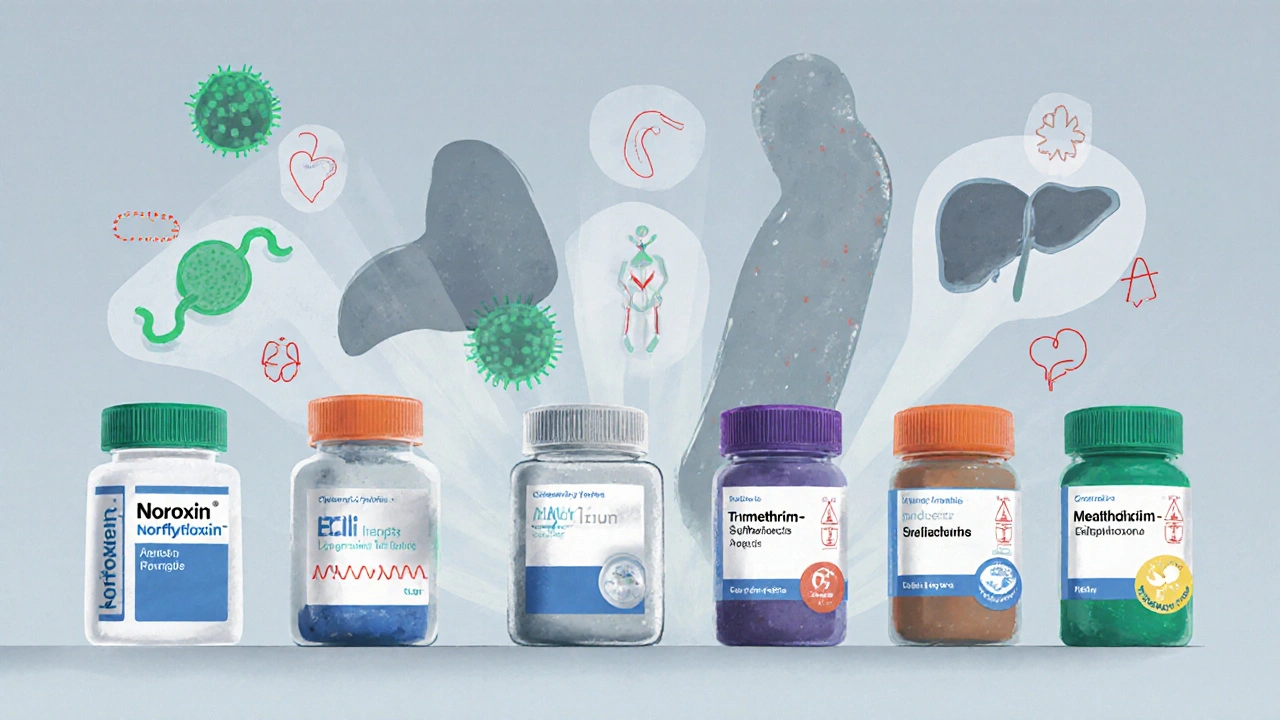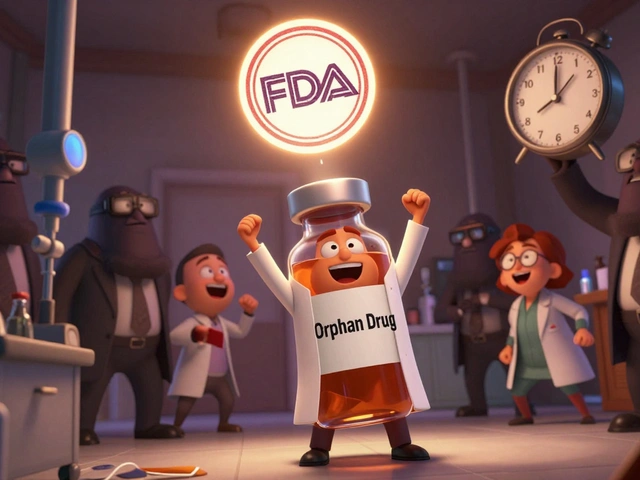Noroxin (Norfloxacin) vs Alternative Antibiotics: Full Comparison Guide

Antibiotic Choice Advisor
Enter your details and click "Find Recommended Antibiotic" to get personalized recommendations.
When a urinary‑tract infection or a skin infection pops up, doctors often reach for a fluoroquinolone. Noroxin is a brand name for norfloxacin, a synthetic fluoroquinolone antibiotic that blocks bacterial DNA replication. It’s effective, but it’s not the only option on the shelf. This guide lines up Noroxin against the most common alternatives so you can see where it shines, where it falls short, and which drug might be the right fit for a given infection.
- Noroxin treats uncomplicated UTIs and some gastrointestinal infections but carries a higher risk of tendon injury than newer fluoroquinolones.
- Levofloxacin and ciprofloxacin offer broader gram‑negative coverage and are usually first‑line for respiratory infections.
- Trimethoprim‑sulfamethoxazole (Bactrim) is a cheap, well‑tolerated option for many UTIs, but resistance is rising.
- Amoxicillin remains the go‑to for streptococcal throat infections, though it’s not a fluoroquinolone.
- Cost, side‑effect profile, and local resistance patterns should drive the final pick.
What is Noroxin (Norfloxacin)?
Norfloxacin was approved by the FDA in 1988 and belongs to the fluoroquinolone class. It works by inhibiting bacterial enzymes DNA gyrase and topoisomerase IV, which stops the bacteria from copying their DNA. Because of this mechanism, it’s bactericidal - it kills the bugs rather than just holding them back.
Typical adult dosing for an uncomplicated urinary‑tract infection (UTI) is 400mg twice a day for three days. For gastrointestinal infections like shigellosis, the regimen may stretch to five days. The drug is taken with a full glass of water, and patients are advised to stay well‑hydrated to reduce the risk of crystalluria.
Key alternatives to Noroxin
Below are the most frequently prescribed antibiotics that compete with Noroxin for similar infection types.
Ciprofloxacin - another fluoroquinolone, broader spectrum against gram‑negative rods, often used for prostatitis and complicated UTIs.
Levofloxacin - a third‑generation fluoroquinolone with excellent lung penetration, making it a top choice for community‑acquired pneumonia.
Moxifloxacin - a newer fluoroquinolone with added activity against anaerobes; useful for intra‑abdominal infections.
Trimethoprim‑sulfamethoxazole (often sold as Bactrim) - a combination that blocks folic‑acid synthesis in bacteria; cheap, but resistance varies by region.
Amoxicillin - a beta‑lactam that targets gram‑positive and some gram‑negative organisms; not a fluoroquinolone but commonly considered when choosing an oral antibiotic.
Side‑effect and safety snapshot
| Antibiotic | Common AEs | Serious Risks | Contra‑indications |
|---|---|---|---|
| Noroxin (Norfloxacin) | GI upset, headache, dizziness | Tendon rupture, QT prolongation | Pregnancy, children <12, history of tendon disorders |
| Ciprofloxacin | Nausea, photosensitivity | Peripheral neuropathy, severe tendon injury | Pregnancy, seizure disorders |
| Levofloxacin | Insomnia, mild rash | QT prolongation, Clostridioides difficile infection | Myasthenia gravis, renal failure without dose adjustment |
| Moxifloxacin | Diarrhea, dizziness | Hepatotoxicity, severe allergic reactions | History of liver disease, > 65y with cardiac disease |
| Trimethoprim‑sulfamethoxazole | Pruritus, mild nausea | Stevens‑Johnson syndrome, severe hyperkalemia | Renal impairment, sulfa allergy, pregnancy (first trimester) |
| Amoxicillin | Diarrhea, mild rash | Anaphylaxis (rare) | Penicillin allergy, severe renal impairment without adjustment |

How to decide which drug fits your infection
Think of the choice as a decision tree. Start with the infection type, then ask four questions:
- Is the pathogen known? - If a culture shows Escherichia coli that’s fluoroquinolone‑sensitive, Noroxin or ciprofloxacin are viable.
- What is the patient’s risk profile? - A 70‑year‑old with a history of tendonitis should avoid Noroxin and ciprofloxacin; levofloxacin may be safer if cardiac monitoring is possible.
- Are there local resistance patterns? - In regions where E. coli resistance to fluoroquinolones exceeds 20%, trimethoprim‑sulfamethoxazole often outperforms.
- What’s the cost ceiling? - Generic Noroxin costs roughly CAD$0.45 per 400mg tablet, while brand‑name levofloxacin can be twice that; trimethoprim‑sulfamethoxazole is usually the cheapest.
Plugging the answers into the matrix below helps narrow the field.
| Scenario | First‑line | Backup if contraindicated |
|---|---|---|
| Uncomplicated UTI, low tendon‑risk | Noroxin | Trimethoprim‑sulfamethoxazole |
| Complicated UTI, high resistance | Ciprofloxacin | Levofloxacin |
| Community‑acquired pneumonia | Levofloxacin | Moxifloxacin |
| Skin and soft‑tissue infection, pen‑allergy | Trimethoprim‑sulfamethoxazole | Clindamycin (outside scope) |
| Pediatric streptococcal pharyngitis | Amoxicillin | Azithromycin (outside scope) |
Cost and availability in 2025
In Canada, Noroxin is available as a generic tablet for about CAD$0.45 per dose, making a three‑day course roughly CAD$2.70. Ciprofloxacin generic is slightly cheaper at CAD$0.35 per 500mg tablet. Levofloxacin tablets cost around CAD$0.80 each, while moxifloxacin sits near CAD$1.20. Trimethoprim‑sulfamethoxazole is often covered by provincial drug plans, costing less than CAD$0.20 per tablet. Amoxicillin remains the most affordable, typically under CAD$0.15 per dose.
Insurance formularies usually place fluoroquinolones in a higher tier due to safety concerns, so patients may need prior authorization for Noroxin or ciprofloxacin. Checking with the pharmacy about generic equivalents and therapeutic swaps can shave off a few dollars.
Regulatory outlook and future trends
The World Health Organization has warned that overuse of fluoroquinolones fuels resistance and urges stewardship programs. In 2024, Health Canada added a black‑box warning for all fluoroquinolones, including Noroxin, emphasizing tendon and cartilage toxicity. This pushes clinicians toward narrower‑spectrum agents when possible.
Emerging oral agents like delafloxacin and omadacycline are gaining traction for skin infections, offering similar coverage without the classic fluoroquinolone risks. However, they remain pricier (often CAD$5‑$8 per tablet) and are not yet first‑line for UTIs.
Quick reference cheat sheet
- Noroxin: 400mg BID, 3‑day UTI; watch for tendon pain.
- Ciprofloxacin: 500mg BID, 5‑7days; broad gram‑negative, avoid in pregnancy.
- Levofloxacin: 750mg daily, 5days; excellent lung penetration, QT check.
- Moxifloxacin: 400mg daily, 5‑7days; anaerobe coverage, liver monitoring.
- Trimethoprim‑sulfamethoxazole: 800/160mg BID, 3days; cheap, resistance variable.
- Amoxicillin: 500mg TID, 7‑10days; first‑line for streptococci, safe in pregnancy.

Frequently Asked Questions
Can I take Noroxin if I’m pregnant?
No. Noroxin is classified as pregnancy category C and has been linked to fetal cartilage damage in animal studies. Safer options like amoxicillin or nitrofurantoin are preferred.
Why do fluoroquinolones cause tendon injuries?
Fluoroquinolones interfere with collagen synthesis and degrade extracellular matrix, weakening tendons-especially the Achilles. The risk rises after age 60 or with concurrent corticosteroid use.
Is there a resistance issue with Noroxin?
Yes. In many North American regions, fluoroquinolone resistance in E. coli exceeds 20%, making Noroxin less reliable for UTIs. Local antibiograms should guide therapy.
How does the cost of Noroxin compare to other fluoroquinolones?
Noroxin’s generic price is around CAD$0.45 per tablet, slightly higher than ciprofloxacin (≈CAD$0.35) but lower than levofloxacin (≈CAD$0.80). Insurance formularies may add extra out‑of‑pocket costs for higher‑tier drugs.
When should I choose trimethoprim‑sulfamethoxazole over Noroxin?
If the patient is under 65, has no sulfa allergy, and local E. coli susceptibility is >80%, trimethoprim‑sulfamethoxazole is a cheaper, well‑tolerated first‑line option for uncomplicated UTIs.






Hutchins Harbin
October 3, 2025 AT 16:02Reading through the Noroxin guide felt like stepping onto a stage where the drama of antimicrobial stewardship unfolds; the tendon‑risk warnings echo like a tragic foreshadowing, reminding us that every prescription carries a hidden cost. While the guide outlines the cost advantages neatly, one cannot ignore the lingering specter of Achilles rupture that haunts older patients. The comparison tables are crisp, but a deeper dive into local resistance patterns would elevate the piece from informative to indispensable. Moreover, the inclusion of emerging agents such as delafloxacin hints at future battles against resistance, yet the narrative stops short of exploring their pharmacoeconomic impact. In short, the article delivers a solid foundation, but the dramatic tension of clinical decision‑making deserves a more vivid spotlight.
Benjamin Herod
October 5, 2025 AT 02:14Allow me to extend my gratitude for the thorough exposition presented herein; the author has admirably synthesized a breadth of pharmacologic data into a cohesive tableau that serves both novice and seasoned clinicians alike. The historical context of Noroxin's FDA approval in 1988 is a commendable inclusion, demonstrating an awareness of the evolutionary trajectory of fluoroquinolones. It is particularly noteworthy that the guide delineates the nuanced interplay between tendon risk and patient age, thereby providing a pragmatic framework for risk stratification. While the cost analysis is robust, one might argue that a deeper exploration of health‑system level formularies would further enrich the discourse. The mention of emerging agents such as delafloxacin and omadacycline, though brief, serves as a harbinger of the shifting therapeutic landscape. Nonetheless, the omission of detailed pharmacokinetic parameters-such as volume of distribution and half‑life-represents a missed opportunity for a truly exhaustive reference. The tables, though informative, could benefit from visual enhancements to aid rapid assimilation of data. Additionally, the guide's emphasis on local antibiograms aligns with contemporary stewardship principles, a point that cannot be overstated. In conclusion, the manuscript stands as a valuable adjunct to clinical decision‑making, albeit with room for augmentation in certain pharmacological specifics.
luemba leonardo brás kali
October 6, 2025 AT 12:26The guide does a solid job of contrasting Noroxin with its alternatives, especially when it comes to the spectrum of activity and side‑effect profiles. From a cultural standpoint, it’s helpful that the author mentioned Canadian pricing, as drug costs vary globally. The resistance data for E. coli is particularly relevant for clinicians in North America, but readers elsewhere might need to consult local antibiograms. Overall, the article is grammatically precise and easy to follow.
Corey McGhie
October 7, 2025 AT 22:38Great rundown, really. I love how you laid out the decision tree-makes the whole thing feel less like a maze and more like a choose‑your‑own‑adventure, except the stakes are real infections. Of course, if you’re over 65 and think you can handle a fluoroquinolone, you might end up with a broken Achilles and an even bigger problem. So, maybe a dash of sarcasm: sure, take Noroxin, if you enjoy drama at the pharmacy counter.
Ajayi samson
October 9, 2025 AT 08:50Wow, you really think Noroxin is a good first‑line choice? That’s reckless. Anyone reading this should know the tendon‑rupture risk alone makes it a poor pick for most patients, especially when cheaper, safer options exist. The guide glosses over the resistance stats, which is a huge oversight.
Lief Larson
October 10, 2025 AT 19:02The article is good but could use more about local cost differences it really helps patients see what they can afford.
Julia Grace
October 12, 2025 AT 05:14Hey folks! I found the quick reference cheat sheet super helpful-love the colorful bullet points! If you’re wondering about side effects, just remember: tendon pain = stop the drug ASAP. Hope this helps someone out there!
Sadie Bell
October 13, 2025 AT 15:26Let’s keep it moving-choose the safest antibiotic and you’ll feel like a champion of your own health journey!
Noah Bentley
October 15, 2025 AT 01:38Grammar check: this guide nails the facts.
Kathryn Jabek
October 16, 2025 AT 11:50In the grand tapestry of antimicrobial therapy, one must contemplate the ethical ramifications of deploying a fluoroquinolone whose very mechanism may precipitate the rupture of a tendon, thereby intertwining pharmacology with the very biomechanics of the human form. Thus, while the guide provides an admirable comparative matrix, the philosophical weight of prescribing such agents cannot be dismissed.
Ogah John
October 17, 2025 AT 22:02Interesting read-though I’d argue the decision‑tree could be more nuanced. Patients on steroids, for example, deserve an extra caution flag beyond just “high tendon risk”.
Kelvin Murigi
October 19, 2025 AT 08:14The guide nails the essentials while also offering a pragmatic lens on cost and safety. For clinicians juggling formularies, the reminder about insurance tiering for fluoroquinolones is pure gold. Keep these updates coming!
ahmad matt
October 20, 2025 AT 18:26Honestly this guide feels like it’s trying to be everything at once-cost, safety, resistance-yet it ends up being a jack‑of‑all‑trades, master of none. A sharper focus would serve the audience better.